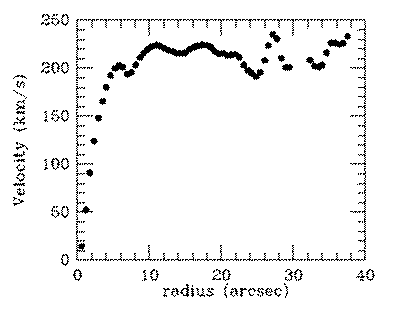
Source http://astrosun.tn.cornell.edu/courses/astro201/rotation_flat.htm
The main evidence for dark
matter comes from rotation curves of disk galaxies. A
rotation curve measures the rate at which stars and/or gas move in their
circular orbits around the center of the galaxy. In general these are "flat",
as shown in the next figure:
For more information click on the image.

Source
http://astrosun.tn.cornell.edu/courses/astro201/rotation_flat.htm
The rotation curve of the milky way is much harder to measure than for external galaxies, since the gas and stars beyond the solar circle are moving mostly transverse to the line-of-sight rather than along it. However, so many rotation curves have been measured for other disk galaxies there is no reason to suppose that the Milky Way would be particularly different, so even if the flattness of the rotation of the outer Galaxy is poorly measured it is thought to be flat nevertheless. Improved astrometric space missions within a decade or two will resolve this observational difficulty.
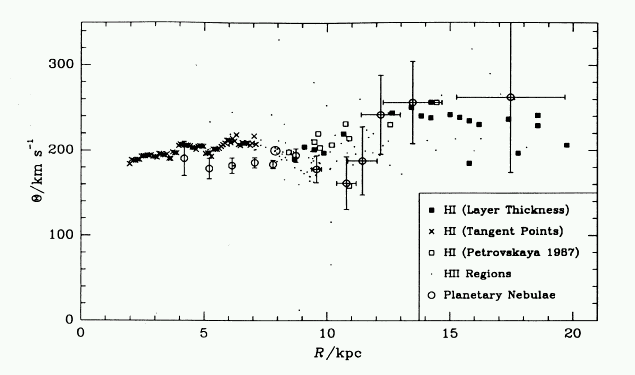
Source
Merrifield 1992. http://adsbit.harvard.edu/cgi-bin/nph-iarticle_query?1992AJ....103.1552M
The Sun moves at about 220 km/s in a circular orbit around the center of the galaxy, like almost all the stars near the Sun. We can estimate the amount of matter inside the Sun's orbit by assuming that all the matter is at the Galactic center, a not too bad approximation.
Let the speed be V0 , the mass of the Galaxy be MG and the distance of the Sun from the Galactic center be R0. Then the centrifugal force due to rotational speed must balance the gravitational force due to the mass of the Galaxy.
GMG/R02 = V02/R0
where G is the gravitational constant.
Hence
MG = V02 R0/G
substituting values of 8 kpc and 220 km/s for the Sun and G = 0.00430 M0 (km/s)2 / pc, we get
MG = 1011 M0 (i.e. the mass of the Galaxy within a radius of 8 kpc from the center outwards).
This is already quite close to the mass determination of 6 x 1011 M0 obtained by more realistic modelling of the disk, showing that the approximation is not too bad.
However, measurements of the rotation of the outer edge of the Milky Way show that the stars out there also rotate at 220 km/s, out to about 20 kpc.
Thus, within a radius of 20 kpc we get a mass of
MG = 2x1011 M0.
If the light distribution of the Galaxy were proportional to the mass distribution, then the two mass estimates above would imply that the amount of light emitted by the 8 kpc region would be the same as the region from 8 kpc to 20 kpc... whereas measurements show that the 8 kpc region emits about 10 times more light than the 8 kpc to 20 kpc region.
The major conclusion is that the distribution of emitted light is not necessarily the same as the underlying distribution of matter.
Rotation curves of other galaxies
On the left, a spiral galaxy
image, with spiral arms delineated by HII regions. On the right, the light
a narrow strip running along the major axis of the galaxy has been spread
into a spectrum, between about 6500 and 6800 Angstroms. The rotation of
the galaxy is seen in the emission lines from H alpha at 6563 Angstroms
(the brightest line), as well as other fainter lines in this region due
to [NII]. HII regions appear reddish in this image because of the prominence
of the H alpha line in the red region of the spectrum.
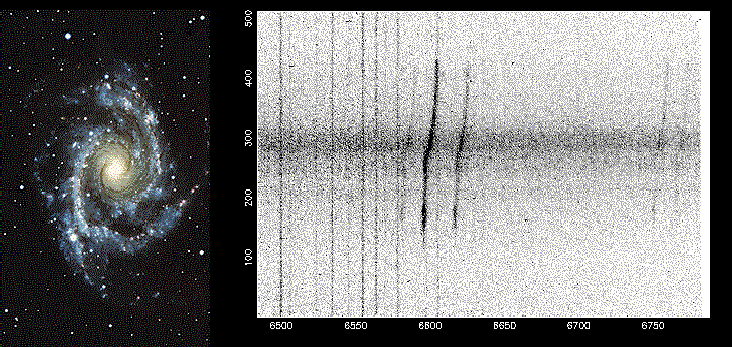
Distant galaxies, at redshifts as high as z = 0.5, seem to display the same kind of rotation curves as nearby galaxies, indicating the problem of the dark matter is not just a local one.
source Fuchs et al 1998,
A&A, 336, 878
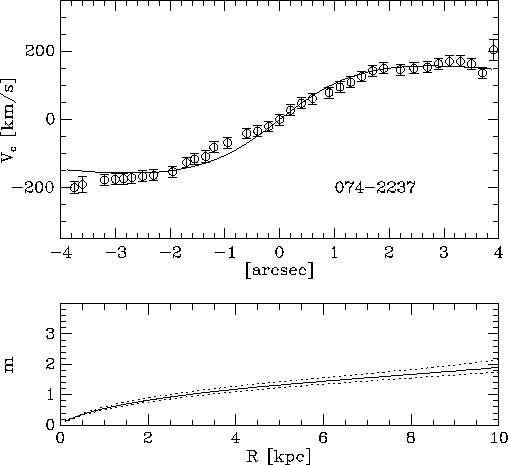
In lecture 4 we developed a mass model for the milky way ---
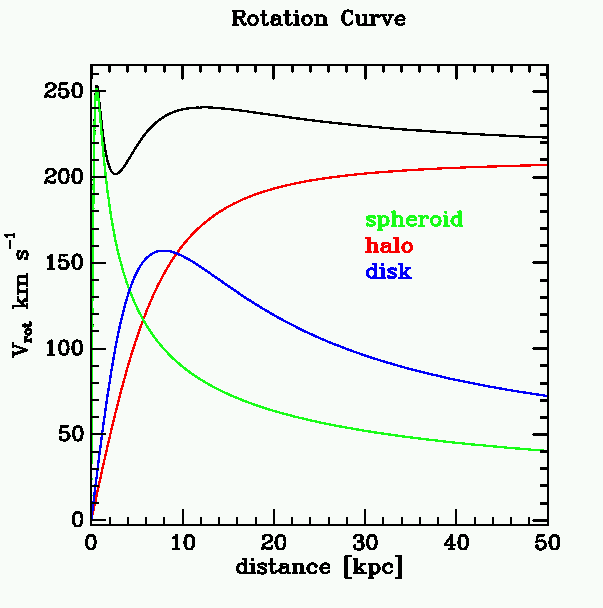
The outer parts of this
model are completely dominated by the dark matter halo. Despite being the
closest galaxy to us, we cannot really measure the outer rotation rate
of our own galaxy, so if it were not for external galaxies the case for
dark matter would be quite weak.
Clusters of Galaxies
Galaxies almost always come in groups of a few (such as the Local Group) to as many as a few thousand (e.g. the Virgo cluster). These mass concentrations thus contain tracer particles (the galaxies themselves) which can be used to reconstruct the mass distribution of the total system). A dark matter problem emerges in these studies which is even more serious than the one for the Galaxy (i.e. individual galaxies) mentioned above.
Source : http://imagine.gsfc.nasa.gov/docs/features/topics/clusters_group/virgo_rosat.html
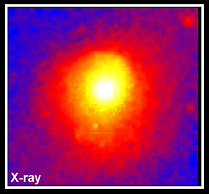 |
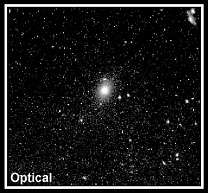 |
These images, an optical (left) and X-ray (right) are of the galaxy cluster Virgo. The optical image shows the visible galaxies in the cluster, while the X-ray image displays the hot gas between the galaxies.
This ROSAT
image (right) of the Virgo cluster
of galaxies reveals a hot X-ray emitting plasma
or gas with a temperature of 10-100 million degrees pervading the cluster.
False colors have been used to represent the intensity of X-ray emission.
The large area of X-ray emission, just below and left of center, is about
1 million light-years across. The giant elliptical
galaxy M87, the biggest member of the cluster, is centered in that area
while other cluster members are scattered around it. By adding up the amount
of X-ray emitting gas astronomers have found that its total mass
is up to 5 times the total mass of the cluster galaxies themselves - yet
all this matter still does not produce nearly enough gravity
to keep the cluster from flying apart! Where is the unseen mass? Because
galaxy clusters are the largest structures in the Universe, this mysterious
Dark Matter must dominate the cosmos but its nature is still an open question.
Dark matter and the eary Universe
The formation of structure
(galaxies and stars) in the early Universe appears to require large amounts
of dark matter in order to proceed to the kind of Universe we observe today.
This kind of evidence for dark matter is much less direct than the studies
mentioned above but is nevertheless quite persausive.
Source : http://zeus.ncsa.uiuc.edu:8080/Summers/expand.html
 Credits: Barry
Sanders, NCSA
Credits: Barry
Sanders, NCSA
The sequence opens with a blue-white marble centered in the IMAX screen. Rocky Kolb, an astrophysicist at Fermilab, is describing how the entire observable universe; all the planets, stars, and galaxies we see; was once compressed to the size of this marble in the very early universe. The evolution of the universe begins with a furious expansion as the marble quickly fills the screen and beyond. As the expansion continues, its initially rapid pace begins to abate, reflecting the slowing of the real universe due to its own gravitation self-attraction.
The universe is, at this stage, almost completely featureless with density fluctuations of less than one part in a billion. Nevertheless, slight variations in density do exist and are the seeds of the galaxies we see around us at the present. To create a visualization, only the fluctuations in the density field are shown (else the screen would appear too smooth and one would not be able to see the expansion). These fluctuations have a slowly varying color, from blue to red, as the universe cools (note that in color temperature, "blue hot" is hotter than "red hot"). Towards the end of the segment, the universe is no longer hot enough to keep protons and electrons apart and they combine to form hydrogen atoms. This transition marks the phase known as 'recombination' and is schematically depicted on the IMAX screen by a sharp increase in the transparency of the fluctuations. The sequence ends with a cross-dissolve to the hierarchical collapse and galaxy formation simulation.
For more information about the physics behind this sequence and cosmology in general, see Cosmos in a Computer, a hypermedia exhibit on computational cosmology.
Credits: Greg Bryan (Illinois)
First, we show an example of the fluctuations typical of what is called the Harrison-Zel'dovich spectrum, which is the underlying description of density fluctuations for most of this sequence. This spectrum of fluctuations assumes that the universe has no preferred length scale and may be naturally produced by quantum fluctuations during an inflationary epoch (90k).
The second image shows fluctuations for a range of different physical scales, ranging from the Harrison-Zel`dovich spectrum in the upper-left corner, to one thought more likely to describe the seeds out of which our own galaxy grew (lower-right). During the visualization sequence, the character of the fluctuations slowly changes through these stages as the universe expands. (83k)
This kind of structure develops via gravitational contraction :
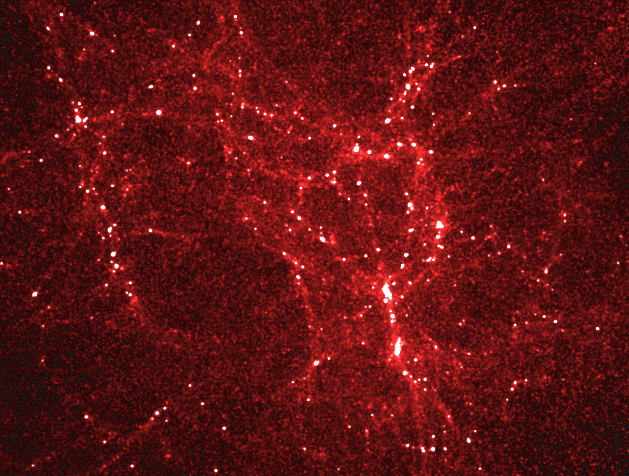
and the white areas above represent concentrations where clusters of galaxies begin to form
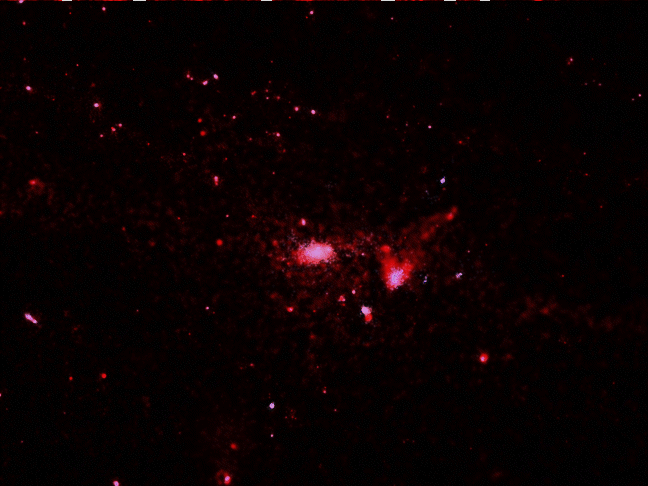
Above is an "image" of a galaxy forming in the comouter simulation.
Below a 3-D image of the kind of structure the emerges :
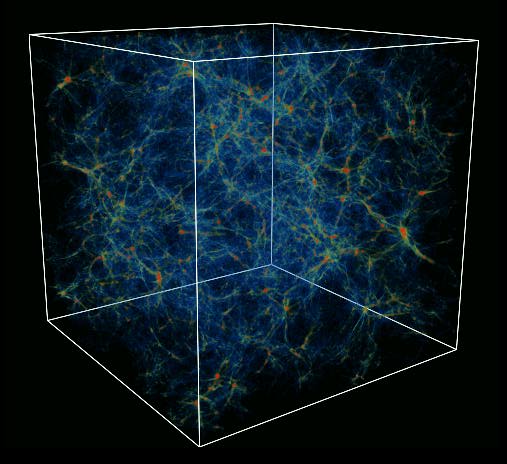
Movie version of this : click here
Movie version of a cluster forming : click here
Movie showing final state of cluster: click here
Final state of the system : (source Dubinski 1999, ApJ)
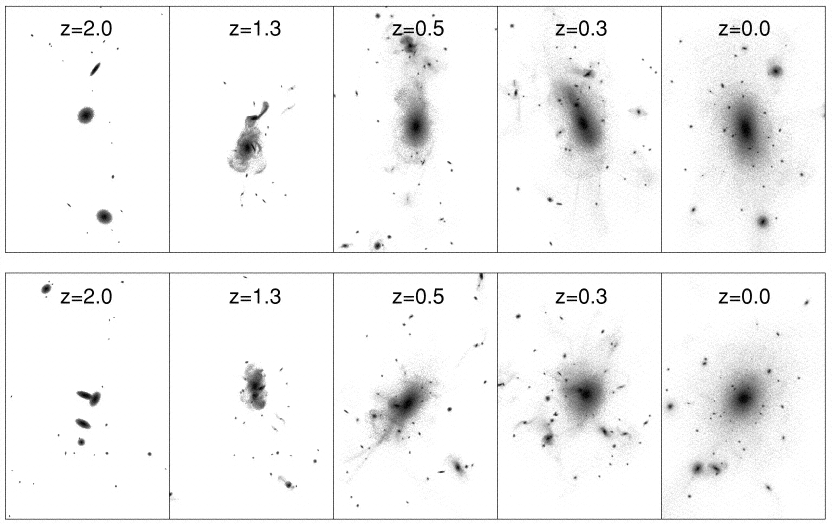
Timing the local group
Andromeda (M31) is probably
going to crash into the Milky Way within 10-15 Gyr. This is unexpected
unless the Local Group is much more massive than it appears --- it would
have enough kinetic energy to delay such a collision. The simulation
below shows a sophisticated modelling of the motions of most of the objects
within the local group --- the idea being to try and figure out the past
history of the group. Such simulations also indicate that the Galaxies
must contain large amounts of dark matter in order that the system doesn't
fly apart well before the present (it is still very much bound!).
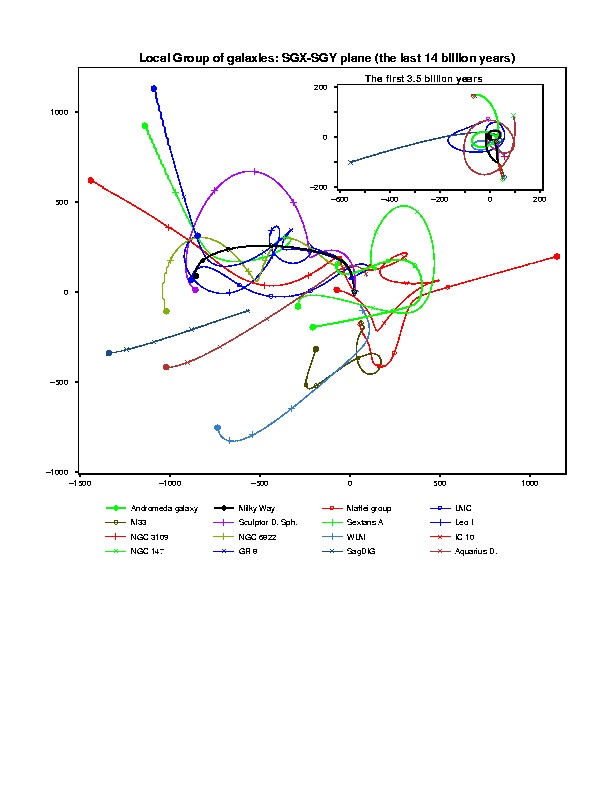
Gravitational Lenses
Mass can bend light, and if it is compact enough focus it like a telescope. The following image shows how distant (background galaxies) have been magnified and distorted by the matter distribution in a foreground cluster of galaxies.
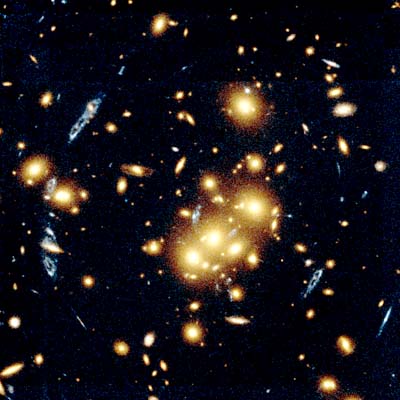
Source : http://oposite.stsci.edu/pubinfo/pr/96/10/A.html
This Hubble Space Telescope image shows several blue, loop-shaped objects
that actually are multiple images of the same galaxy. They have been duplicated
by the
gravitational lens of the cluster of yellow, elliptical and spiral
galaxies - called 0024+1654 - near the photograph's center. The gravitational
lens is produced by the
cluster's tremendous gravitational field that bends light to magnify,
brighten and distort the image of a more distant object. How distorted
the image becomes and
how many copies are made depends on the alignment between the foreground
cluster and the more distant galaxy, which is behind the cluster.
In this photograph, light from the distant galaxy bends as it passes
through the cluster, dividing the galaxy into five separate images. One
image is near the center of
the photograph; the others are at 6, 7, 8, and 2 o'clock. The light
also has distorted the galaxy's image from a normal spiral shape into a
more arc-shaped object.
Astronomers are certain the blue-shaped objects are copies of the same
galaxy because the shapes are similar. The cluster is 5 billion light-years
away in the
constellation Pisces, and the blue-shaped galaxy is about 2 times farther
away.
Though the gravitational light-bending process is not new, Hubble's
high resolution image reveals structures within the blue-shaped galaxy
that astronomers have
never seen before. Some of the structures are as small as 300 light-years
across. The bits of white imbedded in the blue galaxy represent young stars;
the dark core
inside the ring is dust, the material used to make stars. This information,
together with the blue color and unusual "lumpy" appearance, suggests a
young,
star-making galaxy.
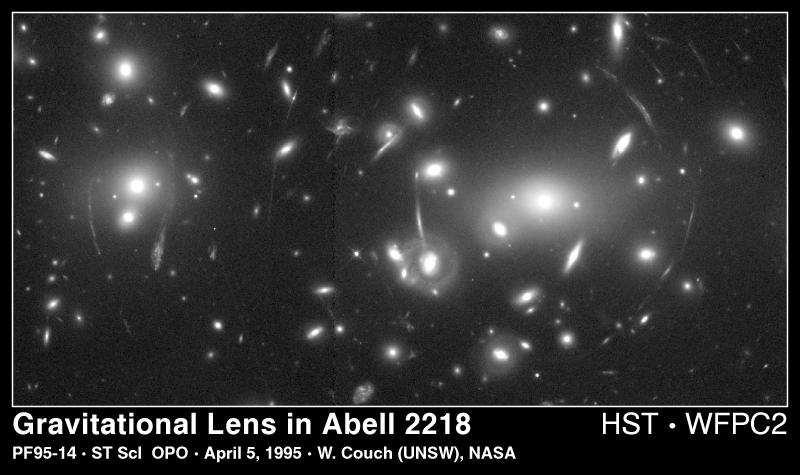
HUBBLE VIEWS DISTANT GALAXIES THROUGH A COSMIC LENS
Source : http://oposite.stsci.edu/pubinfo/pr/95/14.html
This NASA Hubble Space Telescope image of the rich galaxy cluster, Abell 2218, is a spectacular example of gravitational lensing. The arc-like pattern spread across the picture like a spider web is an illusion caused by the gravitational field of the cluster.
The cluster is so massive and compact that light rays passing through it are deflected by its enormous gravitational field, much as an optical lens bends light to form an image. The process magnifies, brightens and distorts images of objects that lie far beyond the cluster. This provides a powerful "zoom lens" for viewing galaxies that are so far away they could not normally be observed with the largest available telescopes.
Hubble's high resolution reveals numerous arcs which are difficult to detect with ground-based telescopes because they appear to be so thin. The arcs are the distorted images of a very distant galaxy population extending 5-10 times farther than the lensing cluster. This population existed when the universe was just one quarter of its present age. The arcs provide a direct glimpse of how star forming regions are distributed in remote galaxies, and other clues to the early evoution of galaxies.
Hubble also reveals multiple imaging, a rarer lensing event that happens when the distortion is large enough to produce more than one image of the same galaxy. Abell 2218 has an unprecedented total of seven multiple systems.
The abundance of lensing features in Abell 2218 has been used to make
a detailed map of the distribution of matter in the cluster's center. From
this, distances can be calculated for a sample of 120 faint arclets found
on the Hubble image. These arclets represent galaxies that are 50
times fainter than objects that can be seen with ground-based telescopes.
Maps of the matter in the foreground system which could produce the lensing seen need to include lots of dark matter.
Machos
Lensing can take place nearer to home --- between us and the Magellanic clouds for example... such events are called microlensing.
One project to detect microlensing has been going on in Australia at Mount Stromlo for some years. The objects they are looking for are dark matter particles in the dark halo of the Galaxy, which would microlens (or magnify) a distant star in the Magellanic cloud as they pass it on the sky. This is a very rare event, taking place only about once per million stars, so many stars have to be watched similtaneously in order for this to be practical.

Here is one of the stars which was microlesed.
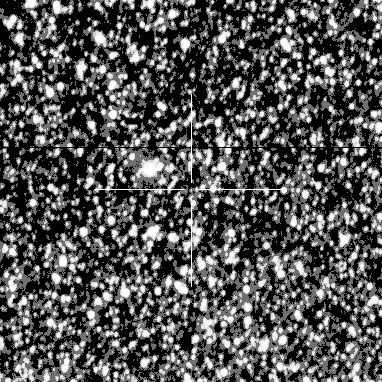
One important aspect of
microlensing is that brightens and fades in the same way in different filters.
THis project (amongst several others) has found about half the microlensing
events expected if the dark halo were made entirely of low mass objects,
about 0.5 solar masses. At present this is a very active field and the
exact meaning of these results is very unclear.
Searching for dark matter
Having convinced ourselves
that there is something out there that we can't see, one can naturally
ask what it might be made of.
Conservative candidates
include gas, dust, low mass stars (red dwarfs), large planets (Jupiters),
cold gas clouds. The main advantage of these candidates is that they are
all known to be able to actually exist. More exotic possibilities are a
swarm of candidates amongst the fundamental particles, some known to exist,
some not.
One thing worked on very recently is faint stars, such as M dwarfs. These are sufficiently faint that they would not have been seen from the ground amongst all the more numerous galaxies, but could be detected directly with the space telescope.